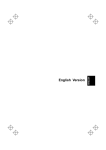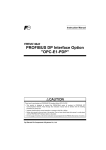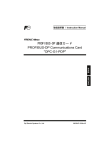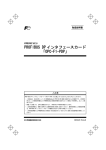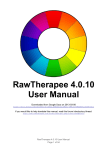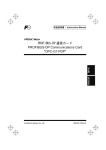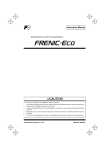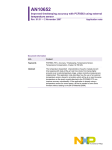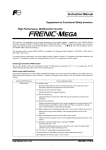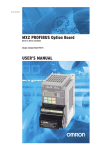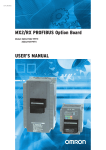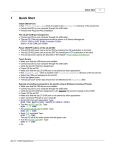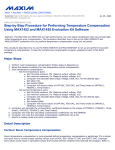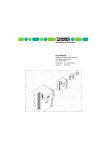Download OPC-PDP2 - Fuji Electric GmbH
Transcript
取扱説明書 / Instruction Manual PROFIBUS-DP 通信カード PROFIBUS-DP Communications Card "OPC-G1-PDP2" ENGLISH 日本語 Fuji Electric Systems Co., Ltd. INR-SI47-1527-JE Copyright © 2010 Fuji Electric Systems Co., Ltd. All rights reserved. この取扱説明書の著作権は,富士電機システムズ株式会社にあります。 本書に掲載されている会社名や製品名は,一般に各社の商標または登録商標です。 仕様は予告無く変更することがあります。 No part of this publication may be reproduced or copied without prior written permission from Fuji Electric Systems Co., Ltd. All products and company names mentioned in this manual are trademarks or registered trademarks of their respective holders. The information contained herein is subject to change without prior notice for improvement. ENGLISH English Version Preface Thank you for purchasing our PROFIBUS-DP Communications Card OPC-G1-PDP2. This manual has been prepared to help you connect your FRENIC-MEGA to a PROFIBUS-DP master (Siemens PLC, computer, etc.) via PROFIBUS-DP. Mounting the communications card on your FRENIC-MEGA allows you to connect the FRENIC-MEGA to a PROFIBUS-DP master node and control it as a slave unit using run and frequency commands, and access to function codes. The communications card can be connected to the A-port only, out of three option connection ports (A-, B-, and C-ports) provided on the FRENIC-MEGA. It has the following features: - PROFIBUS version: DP-V0 compliant Transmission speed: 9,600 bps to 12 Mbps Maximum network cable length per segment: 100 m (12 Mbps) to 1200 m (9.6 kbps) Applicable Profile: PROFIDrive V2 compliant Able to read and write all function codes supported in the FRENIC-MEGA This instruction manual does not contain inverter handling instructions. Read through this instruction manual in conjunction with the FRENIC-MEGA Instruction Manual and be familiar with proper handling and operation of this product. Improper handling might result in incorrect operation, a short life, or even a failure of this product. Keep this manual in a safe place. Related Publications Listed below are the other materials related to the use of the PROFIBUS-DP Communications Card OPC-G1-PDP2. Read them in conjunction with this manual as necessary. The materials are subject to change without notice. Be sure to obtain the latest editions for use. • Read through this instruction manual and be familiar with the PROFIBUS-DP communications card before proceeding with installation, connections (wiring), operation, or maintenance and inspection. • Improper handling might result in incorrect operation, a short life, or even a failure of this product as well as the motor. • Deliver this manual to the end user of this product. Keep this manual in a safe place until this product is discarded. Safety precautions Read this manual thoroughly before proceeding with installation, connections (wiring), operation, or maintenance and inspection. Ensure you have sound knowledge of the device and familiarize yourself with all safety information and precautions before proceeding to operate the inverter. Safety precautions are classified into the following two categories in this manual. Failure to heed the information indicated by this symbol may lead to dangerous conditions, possibly resulting in death or serious bodily injuries. Failure to heed the information indicated by this symbol may lead to dangerous conditions, possibly resulting in minor or light bodily injuries and/or substantial property damage. Failure to heed the information contained under the CAUTION title can also result in serious consequences. These safety precautions are of utmost importance and must be observed at all times. 1 ENGLISH • RS-485 Communication User's Manual • FRENIC-MEGA Instruction Manual Installation and wiring • Before starting installation and wiring, turn OFF the power and wait at least five minutes for inverters with a capacity of 22 kW or below, or at least ten minutes for inverters with a capacity of 30 kW or above. Make sure that the LED monitor and charging lamp are turned OFF. Further, make sure, using a multimeter or a similar instrument, that the DC link bus voltage between the terminals P(+) and N(-) has dropped to the safe level (+25 VDC or below). • Qualified electricians should carry out wiring. Otherwise, an electric shock could occur. • Do not use the product that is damaged or lacking parts. Doing so could cause a fire, an accident, or injuries. • Prevent lint, paper fibers, sawdust, dust, metallic chips, or other foreign materials from getting into the inverter and the communications card. Otherwise, a fire or an accident might result. • Incorrect handling in installation/removal jobs could cause a failure. A failure might result. • Noise may be emitted from the inverter, motor and wires. Implement appropriate measure to prevent the nearby sensors and devices from malfunctioning due to such noise. Otherwise, an accident could occur. Operation • Be sure to install the front cover before turning the inverter's power ON. Do not remove the cover when the inverter power is ON. Otherwise, an electric shock could occur. • Do not operate switches with wet hands. Doing so could cause an electric shock. • If you configure the function codes wrongly or without completely understanding FRENIC-MEGA Instruction Manual and the FRENIC-MEGA User's Manual, the motor may rotate with a torque or at a speed not permitted for the machine. Confirm and adjust the setting of the function codes before running the inverter. Otherwise, an accident could occur. Maintenance and inspection, and parts replacement • Before proceeding to the maintenance/inspection jobs, turn OFF the power and wait at least five minutes for inverters with a capacity of 22 kW or below, or at least ten minutes for inverters with a capacity of 30 kW or above. Make sure that the LED monitor and charging lamp are turned OFF. Further, make sure, using a multimeter or a similar instrument, that the DC link bus voltage between the terminals P(+) and N(-) has dropped to the safe level (+25 VDC or below). Otherwise, an electric shock could occur. • Maintenance, inspection, and parts replacement should be made only by qualified persons. • Take off the watch, rings and other metallic objects before starting work. • Use insulated tools. Otherwise, an electric shock or injuries could occur. 2 Disposal • Treat the communications card as an industrial waste when disposing of it. Otherwise injuries could occur. Others • Never modify the communications card. ENGLISH Doing so could cause an electric shock or injuries. Icons The following icons are used throughout this manual. This icon indicates information which, if not heeded, can result in the product not operating to full efficiency, as well as information concerning incorrect operations and settings which can result in accidents. This icon indicates information that can prove handy when performing certain settings or operations. This icon indicates a reference to more detailed information. 3 Table of Contents Preface .......................................................................... 1 Safety precautions............................................................ 1 Chapter 1 BEFORE USE................................................... 5 1.1 Acceptance Inspection ............................................ 5 1.2 Applicable Inverters ................................................. 5 Chapter 2 NAMES AND FUNCTIONS............................... 6 2.1 External Appearance ............................................... 6 2.2 Terminal Block (TERM1).......................................... 6 2.3 Terminating Resistor Switch (SW3) ......................... 7 2.4 Node Address Switches........................................... 7 2.5 Setting the Transmission Speed (Baud Rate).......... 8 2.6 LED Status Indicators .............................................. 8 Chapter 3 INSTALLATION AND REMOVAL OF THE PROFIBUS-DP COMMUNICATIONS CARD .... 9 3.1 Installing the Communications Card ........................ 9 3.2 Removing the Communications Card .................... 10 Chapter 4 WIRING AND CABLING ..................................11 4.1 Basic Connection Diagram .....................................11 4.2 Wiring for PROFIBUS Terminal Block.................... 12 4.3 Wiring to Inverter ................................................... 13 Chapter 5 CONFIGURING INVERTER'S FUNCTION CODES FOR PROFIBUS COMMUNICATION 14 Chapter 6 ESTABLISHING A PROFIBUS COMMUNICATIONS LINK .............................. 15 Chapter 7 QUICK SETUP GUIDE FOR RUNNING THE INVERTER ...................................................... 16 7.1 Before Proceeding to Data Exchange.................... 16 7.2 Data Transaction Examples in Running an Inverter16 Chapter 8 DETAILS OF PROFIBUS PROFILES.............. 19 8.1 Description of PPO Types Supported .................... 19 8.2 PCD Word Area ..................................................... 21 8.3 PCV Word Area...................................................... 26 Chapter 9 ERROR PROCESSING FOR PROFIBUS NETWORK BREAKS ...................................... 33 Chapter 10 PROCESSING TO BE APPLIED UPON RECEIPT OF ALL-ZERO DATA ...................... 34 Chapter 11 LIST OF INVERTER ALARM CODES............. 35 Chapter 12 TROUBLESHOOTING .................................... 36 Chapter 13 SPECIFICATIONS........................................... 37 13.1 General Specifications ........................................... 37 13.2 PROFIBUS-DP Specifications ............................... 37 4 Chapter 1 BEFORE USE 1.1 Acceptance Inspection Unpack the package and check the following: (1) A communications card, two screws (M3 × 8), and the PROFIBUS-DP Communications Card Instruction Manual (this document) are contained in the package. (2) The communications card is not damaged during transportation--no defective parts, dents or warps. (3) The model name "OPC-G1-PDP2" is printed on the communications card. (See Figure 1.1.) If you suspect the product is not working properly or if you have any questions about your product, contact the shop where you bought the product or your local Fuji branch office. Screw hole (left) Release knob Model name CN1 (Front) (Back) Screw hole (right) Positioning cutout Names of Parts on PROFIBUS-DP Communications Card (OPC-G1-PDP2) 1.2 Applicable Inverters The communications card is applicable to the following inverters and ROM version. Table 1.1 Applicable Inverters and ROM Version Series Inverter type Applicable motor rating ROM version FRENIC-MEGA FRNG1- All capacities 1000 or later * The boxes replace alphanumeric letters depending on the nominal applied motor, enclosure, power supply voltage, etc. To check the inverter's ROM version, use Menu #5 "Maintenance Information" on the keypad. (Refer to the FRENIC-MEGA Instruction Manual, Chapter 3, Section 3.4.6 "Reading maintenance information." Table 1.2 Checking the Inverter ROM Version Display on LED Monitor Item 5_14 Inverter's ROM version Description Shows the inverter's ROM version as a 4-digit code. 5 ENGLISH Figure 1.1 Chapter 2 NAMES AND FUNCTIONS 2.1 External Appearance The external appearance and the components of the PROFIBUS-DP communications card are shown in Figure 2.1 and Table 2.1, respectively. SW 2 SW1 SW3 TERM1 Figure 2.1 Table 2.1 CN1 (on t he back) LEDs External View and Component Names Components on the PROFIBUS-DP Communications Card Item Description TERM1 PROFIBUS-DP terminal block (3.5 mm pitch) CN1 Connector for joint with inverter (See Section 2.2.) SW1, SW2 Node address switches (Rotary switches) (See Section 2.4.) SW3 Terminating resistor switch (See Section 2.3.) LEDs LED status indicators (PWR, ERR, ONL and OFFL) (See Section 2.6.) 2.2 Terminal Block (TERM1) The terminal block TERM1 uses a pluggable, six -pin T-junction terminal block (TWIN spring-cage connection) as shown in Figure 2.2. Table 2.2 lists the pin assignment. A typical connector that matches this terminal block is Phoenix Contact TFMC1.5/6-STF-3.5. For details about the TFMC1.5/6-STF-3.5, visit the Phoenix Contact website at: http://www.phoenixcontact.com/ For wiring to the TERM1, refer to Section 4.2 "(3) Wiring to the PROFIBUS terminal block (TERM1)." Table 2.2 Pin # 1 2 3 4 5 6 Pin Assignment on the PROFIBUS Terminal Block Pin Assignment Description Shield Terminal for connecting the cable shield GND / CNTR-N NC / Data transmission control signal (negative) for the repeater +5V NC A-Line Terminal for the negative (-) line of PROFIBUS cable (green wire) B-Line Terminal for the positive (+) line (red wire) CNTR-P Data transmission control signal (positive) for the repeater (direction control) 6 1 2 Figure 2.2 3 4 5 6 PROFIBUS-DP Terminal Block 2.3 Terminating Resistor Switch (SW3) The PROFIBUS-DP communications network requires insertion of line terminating resistors at its both ends. When the communications card is mounted on the inverter at either end of the network, turn this switch ON to insert the terminating resistor. SW3 SW3 ON ON OFF OFF OFF: No insertion of terminating resistor Figure 2.3 ON: Insertion of terminating resistor Terminating Resistor Switch Settings 2.4 Node Address Switches The node address switches (SW1 and SW2) on the communications card are rotary ones that are used to specify the PROFIBUS-DP communications network node address (station address) of the communications card. The setting range is from 0 to 99 in decimal. The SW1 specifies a 10s digit of the node address and the SW2, a 1s digit. The node address can also be specified with the inverter's function code o31. The setting range is from 0 to 125 in decimal. Note that validating the node address specified with the function code o31 requires setting the node address switches to "00." SW1 Figure 2.4 SW2 1. When the inverter is powered OFF: Set SW1 to "2." Set SW2 to "7." 2. Turn the inverter ON to complete the setting procedure. Node Address Setting Example 1 Example 2: Setting the node address 125 using the function code o31 SW1 Figure 2.5 SW2 1. When the inverter is powered OFF: Set both the SW1 and SW2 to "0." 2. Turn the inverter ON and set the function code o31 data to "125." 3. Restart the inverter to complete the setting procedure. Node Address Setting Example 2 1. The node address switches should be accessed with the inverter being OFF. Setting these switches with the inverter being ON requires restarting it to enable the new settings. 2. To enable the node address setting using the function code o31, restart the inverter. 3. Setting the function code o31 data to "126" or greater will cause an error, blinking the ERR LED on the communications card in red and issuing the alarm code er5 from the inverter. * * The er5 does not occur when y98 = 0 (Run/frequency command sources: Inverter) or o27 = 3, 13, 14, or 15 (Error processing after detection of PROFIBUS network break: Keep the current operation, ignoring the communications error). For details, refer to Chapter 9 "ERROR PROCESSING FOR PROFIBUS NETWORK BREAKS." 7 ENGLISH Example 1: Setting the node address 27 using the node address switches 2.5 Setting the Transmission Speed (Baud Rate) No transmission speed setting is required on the communications card (slave). Setting the transmission speed in the PROFIBUS-DP network master node automatically configures the transmission speed of the communications card. The communications card supports the following transmission speeds. 9.6, 19.2, 45.45, 93.75, 187.5, and 500 kbps 1.5, 3, 6, and 12 Mbps 2.6 LED Status Indicators The communications card has four LED status indicators shown in Figure 2.6. They indicate the operation status of the communications card as listed in Table 2.3. Figure 2.6 Table 2.3 Name PWR LED state Meaning Note Normally communicating --- Blinks in green Self-diagnostic test running or initialization in progress during powering on sequence This test takes approx. 0.5 second. Blinks in red PROFIBUS communications error The inverter shows er5. *1 Blinks in red ERR Lights in green OFF OFFL LED Indications and Operation Status Lights in green Lights in red ONL LED Status Indicators Lights in red OFF Hardware error (Communications card not properly mounted or faulty) Wrong configuration of PROFIBUS protocol (Discrepancy between PPO type defined by the inverter's function code o30 and the one defined in the PROFIBUS master node)*2 Wrong configuration of PROFIBUS protocol (The node address is set to 126 or greater.) Online (The communications card communicates normally on the PROFIBUS network.) Not online Offline (The communications card is not connected to PROFIBUS) Not offline The inverter shows er4. --- The inverter shows er5. *1 --------- *1 Configuration for ignoring er5 is possible. For details, refer to Chapter 9 "ERROR PROCESSING FOR PROFIBUS NETWORK BREAKS." *2 PPO (Parameter Process-data Object) type defined in the communications card should be consistent with that in the PROFIBUS-DP master node. To define the PPO type in the communications card, use the inverter's function code o30; to define that in the master node, use a configuration tool designed for the master node. For defining the PPO type in the master node, refer to the documentation of the master node. For details about the PPO type, see Chapter 8, "DETAILS OF PROFIBUS-DP PROFILES." For details about the function code o30, see Chapter 5 "CONFIGURING INVERTER'S FUNCTION CODES FOR PROFIBUS-DP COMMUNICATION." 8 Chapter 3 INSTALLATION AND REMOVAL OF THE PROFIBUS-DP COMMUNICATIONS CARD Before starting installation and wiring, turn OFF the power and wait at least five minutes for inverters with a capacity of 22 kW or below, or at least ten minutes for inverters with a capacity of 30 kW or above. Make sure that the LED monitor and charging lamp are turned OFF. Further, make sure, using a multimeter or a similar instrument, that the DC link bus voltage between the terminals P(+) and N(-) has dropped to the safe level (+25 VDC or below). Otherwise, an electric shock could occur. • Do not use the product that is damaged or lacking parts. Doing so could cause a fire, an accident, or injuries. • Prevent lint, paper fibers, sawdust, dust, metallic chips, or other foreign materials from getting into the inverter and the communications card. Otherwise, a fire or an accident might result. • Incorrect handling in installation/removal jobs could cause a failure. A failure might result. Before mounting the communications card, perform the wiring for the main circuit terminals and control circuit terminals. (1) Remove the front cover from the inverter and expose the control printed circuit board (control PCB). As shown in Figure 3.1, the communications card can be connected to the A-port only, out of three option connection ports (A-, B-, and C-ports) on the control PCB. To remove the front cover, refer to the FRENIC-MEGA Instruction Manual, Chapter 2, Section 2.3. For inverters with a capacity of 30 kW or above, open also the keypad enclosure. (2) Insert connector CN1 on the back of the communications card (Figure 1.1) into the A-port (CN4) on the inverter's control PCB. Then secure the communications card with the two screws that come with the card. (Figure 3.3) Check that the positioning cutout (shown in Figure 1.1) is fitted on the tab (c in Figure 3.2) and connector CN1 is fully inserted (d in Figure 3.2). Figure 3.3 shows the communications card correctly mounted. (3) Perform wiring for the communications card. Refer to Chapter 4 "WIRING AND CABLING." (4) Put the front cover back into place. To put back the front cover, refer to the FRENIC-MEGA Instruction Manual, Chapter 2, Section 2.3. For inverters with a capacity of 30 kW or above, close also the keypad enclosure. Figure 3.1 9 In the case of 0.4 kW ENGLISH 3.1 Installing the Communications Card c Fit the positioning cutout of the communications card over the tab on the inverter to determine the mounting position. d d Insert connector CN1 on the communications card into the A-port on the inverter's control PCB. c Note: Be sure to follow the order of c and d. Inserting CN1 first may lead to insufficient insertion, resulting in a contact failure. Figure 3.2 Mounting the Communications Card (Release knob) Figure 3.3 Mounting Completed 3.2 Removing the Communications Card Remove the two screws that secure the communications card and pull the release knob (shown above) to take the communications card out of the inverter. 10 Chapter 4 WIRING AND CABLING • Before starting installation and wiring, turn the power OFF and wait at least five minutes for inverters with a capacity of 22 kW or below, or at least ten minutes for inverters with a capacity of 30 kW or above. Make sure that the LED monitor and charging lamp are turned OFF. Further, make sure, using a multimeter or a similar instrument, that the DC link bus voltage between the terminals P(+) and N(-) has dropped to the safe level (+25 VDC or below). • Qualified electricians should carry out wiring. Otherwise, an electric shock could occur. • In general, the covers of the control signal wires are not specifically designed to withstand a high voltage (i.e., reinforced insulation is not applied). Therefore, if a control signal wire comes into direct contact with a live conductor of the main circuit, the insulation of the cover might break down, which would expose the signal wire to a high voltage of the main circuit. Make sure that the control signal wires will not come into contact with live conductors of the main circuit. Failure to observe this precaution could cause an electric shock or an accident. Noise may be emitted from the inverter, motor and wires. Take appropriate measures to prevent the nearby sensors and devices from malfunctioning due to such noise. An accident could occur. 4.1 Basic Connection Diagram L1/R U L2/S V L3/T W Motor M OPC-G1-PDP2 Terminating resistor switch (SW3) PROFIBUS connector (TERM1) Shield GND / CNTR-N +5V (*) PROFIBUS cable A-Line B-Line CNTR-P PROFIBUS cable G G (*) Mounting the communications card on the inverter forms this connection. Figure 4.1 Connection Diagram 11 ENGLISH FRENIC-MEGA 4.2 Wiring for PROFIBUS Terminal Block Perform wiring for the communications card observing the precautions below. Refer to the connection diagram shown in Figure 4.1 and the wiring examples shown in Figure 4.3. (1) Turn the inverter's power OFF. (2) To connect the communications card to a PROFIBUS-DP network, use a shielded twist pair cable that complies with the PROFIBUS specifications. The recommended cable is a PROFIBUS FC standard cable 6XV1 830-0EH10 manufactured by Siemens AG. For details about wiring for PROFIBUS, refer to the "Installation Guideline for PROFIBUS-DP/FMS" and "Handbook PROFIBUS Installation Guideline" published by the PROFIBUS Organization. It can be downloaded for free from the PROFIBUS Organization's website at: http://www.profibus.com/pall/meta/downloads/ (3) Wiring to the PROFIBUS terminal block (TERM1) 1) Strip the wire end by 10 mm as shown below. Applicable wire size AWG24 to 16 (0.2 to 1.5 mm2) Strip length of wire end 10 mm Type of screwdriver (tip shape) Flat screwdriver, 0.4 x 2.5 mm For strand wires, the strip length specified above should apply after twisting of them. Before connection to the terminal block, treat the end of the shield with a ferrule and apply insulation to the stripped section with an insulation tube again. If the strip length is out of the specified range, the wire may not be firmly clamped or may be short-circuited with other wires. 2)Insert the end of the stripped wires into the wire inlet on the control circuit terminal. If the insertion is difficult, hold down the clamp release button on the terminal with a flat screwdriver. 3) When disconnecting the wires from the terminal, hold down the clamp release button on the terminal with a flat screwdriver and pull out the wires. Connecting wires to terminal Disconnecting wires from terminal Flat screwdriver Wires Wires Wire inlet Figure 4.2 Clamp release button Connecting/Disconnecting Wires to/from the Terminal To prevent malfunction due to noise, keep the wiring of the PROFIBUS cable away from the main circuit wiring, motor wiring, and other power lines as far as possible. Never install them in the same wire duct. Be sure to connect the shield wires. (4) Complete wiring before turning the inverter ON. • Route the wiring for the control circuit terminals as far from that for the main circuit terminals as possible. Otherwise electric noise may cause malfunctions. • Fix the control circuit wires inside the inverter with a cable tie to keep them away from the live parts of the main circuit (such as main circuit terminal block). Depending upon the wire type and the number of wires used, the front cover may be lifted by the wires, which impedes normal keypad operation. If it happens, change the wire type or size. 12 4.3 Wiring to Inverter Route the wiring of the PROFIBUS cable as far from the wiring of the main circuit as possible. Otherwise electric noise may cause malfunctions. Pass the wires from the communications card between the control circuit terminal block and the front cover. In the case of 0.4 kW • For inverters with a capacity of 30 kW or above In the case of 75 kW Figure 4.3 Examples of Wiring 13 ENGLISH • For inverters with a capacity of 22 kW or below Chapter 5 CONFIGURING INVERTER'S FUNCTION CODES FOR PROFIBUS COMMUNICATION To perform data transmission between the inverter equipped with the communications card and the PROFIBUS-DP master node, configure the function codes listed in Table 5.1. Table 5.2 lists inverter's function codes related to PROFIBUS-DP communication. Configure those function codes if necessary. For details about function codes, refer to the FRENIC-MEGA Instruction Manual, Chapter 5 "FUNCTION CODES" and the RS-485 Communication User's Manual, Chapter 5, Section 5.2 "Data Formats." Table 5.1 Function codes Inverter's Function Code Settings Required for PROFIBUS Communication Description Factory default Function code data o30 *1 Select PPO type (data format) 0 Select from the following: 0, 1, 6 to 255: PPO type 1 2 and 5: PPO type 2 3: PPO type 3 4: PPO type 4 y98 *2 Select run/frequency command sources 0 Select from the following choices: Frequency command source Inverter PROFIBUS Inverter PROFIBUS y98 0 1 2 3 Remarks The selected PPO type should be consistent with that of the master node. Run command source Inverter Inverter PROFIBUS PROFIBUS If there is no special problem with your system, setting y98 = 3 is recommended. *1 After configuring the function code o30, restart the inverter to enable the new settings. For details about the function code o30, refer to Chapter 8 "DETAILS OF PROFIBUS PROFILES." *2 In addition to y98, the FRENIC-MEGA has other function codes related to the run/frequency command source. Configuring those codes realizes more precise selection of the command sources. For details, refer to the descriptions of H30 and y98 in the FRENIC-MEGA Instruction Manual, Chapter 5 "FUNCTION CODES." Table 5.2 Function codes Other Related Function Codes Factory default Description Setting range Remarks o27 *1 Select error processing for PROFIBUS network breaks. 0 0 to 15 o28 *1 Set the operation timer to be used in error processing for network breaks. 0.0 s 0.0 to 60.0 s o31 *2 Set the PROFIBUS network node address. 0 0 to 255 (Effective range: 0 to 125) o32 *3 Select processing to be applied upon receipt of all-zero data 0 0 to 255 (Effective range: 0 to 2) o40 to o43 Specify function codes for cyclical write. 0000 (No assignment) 0000 to FFFF (hex) Specify function codes for cyclical read. 0000 (No assignment) 0000 to FFFF (hex) Show the software version of the PROFIBUS-DP communications card on the LED monitor. Depends on the communications card --4-digit decimal (Only for monitoring) If the version is V.1.23, the LED shows "123." *4 o48 to o51 *4 W90 Valid only when address switches SW1 and SW2 are set to "00." Setting 126 or greater causes an error, flashing the ERR LED and issuing an er5. Valid only when PPO type 2 or 4 is selected. *1 For details about function codes o27 and o28, refer to Chapter 9 "ERROR PROCESSING FOR PROFIBUS NETWORK BREAKS." *2 For details about function code o31, refer to Chapter 2, Section 2.4 "Node Address Switches." *3 For details about function code o32, refer to Chapter 10 "PROCESSING TO BE APPLIED UPON RECEIPT OF ALL-ZERO DATA." *4 For details about function codes o40 to o43 and o48 to o51, refer to Chapter 8, Section 8.2 (4) "PCD1 to PCD4." After configuring function codes o40 to o43 and o48 to o51, restart the inverter to enable the new settings. 14 Chapter 6 ESTABLISHING A PROFIBUS COMMUNICATIONS LINK This chapter guides you to establish a PROFIBUS-DP communications link between the PROFIBUS-DP master node and the communications card mounted on the inverter (slave node). Follow the steps below. Step 1 Configuring the PROFIBUS-DP master node equipment Step 2 Configuring the communications card and inverter's function codes Step 3 Restarting the inverter ⇒ Initiating the PROFIBUS data transaction Each of the above steps is detailed below. Step 1 Configuring the PROFIBUS-DP master node equipment - Specify the master node address (station address) and baud rate. - Register the communications card to the master node using the GSD file prepared for the communications card. - Choose a PPO type (data format) to be applied to the registered option, from PPO type 1 to PPO type 4. For details about the configuration of the PROFIBUS-DP master node equipment, refer to the user’s manual or documentations of your master equipment. For details about PPO types, refer to Chapter 7 "DETAILS OF PROFIBUS PROFILES." IMPORTANT A GSD file, which is required for registering the PROFIBUS-DP communications card to the PROFIBUS master node, does not come with the communications card. It is available as a free download from our website at: http://web1.fujielectric.co.jp/Kiki-Info-EN/User/index.html (Fuji Electric Systems Co., Ltd. Technical Information site) Step 2 Configuring the communications card and inverter’s function codes - Specify the node address that must be identical with the communications card address registered to the master node. - Configure the data of inverter function codes o27 and o28, if needed. - Choose a PPO type from PPO type 1 to PPO type 4, using the inverter’s function code o30. The PPO type must be identical with the one selected for the master node. After changing the data of the function code o30, be sure to restart the inverter. For details about how to specify the node address, refer to Chapter 2 "NAMES AND FUNCTIONS." For details about function codes o27 and o28, refer to Chapter 9 "ERROR PROCESSING FOR PROFIBUS NETWORK BREAKS." Step 3 Restarting the inverter ⇒ Initiating the PROFIBUS data transaction When the inverter equipped with the communications card and the PROFIBUS-DP master node are properly configured and the wiring is correct, restarting the inverter automatically establishes a PROFIBUS communications link, enabling the data transaction between them. The PWR and ONL LEDs on the communications card light in green. Send run and frequency commands from the master to the communications card. For specific data formats and data transaction, refer to Chapter 7 "QUICK SETUP GUIDE FOR RUNNING THE INVERTER" and Chapter 8 "DETAILS OF PROFIBUS PROFILES." For the wiring, refer to Chapter 4 "WIRING AND CABLING." 15 ENGLISH Before downloading, you are requested to register as a member (free of charge). Chapter 7 QUICK SETUP GUIDE FOR RUNNING THE INVERTER This chapter provides a quick setup guide for running the inverter from a PROFIBUS-DP master node according to the simplest data format (PPO type 3), taking an operation example. PPO type 3 is a simple format dedicated to inverter’s run and frequency commands. The description of PPO type 3 in this chapter can apply to other PPO types, except the format assignment maps. To simplify the description, this chapter confines the description to running of an inverter. For more information, refer to Chapter 8 "DETAILS OF PROFIBUS PROFILES." 7.1 Before Proceeding to Data Exchange (1) At the PROFIBUS-DP master node, select PPO type 3 for the communications card. For the setting procedure of PPO types at the PROFIBUS-DP master node, refer to the user's manual of your master node equipment. (2) Set function codes of your inverter as follows. F03 = 60 (Maximum frequency in Hz), y98 = 3 (Validate frequency and run commands from PROFIBUS), and o30 = 3 (Select PPO type 3) Also set the data of function codes o27 and o28, if needed. After settings are completed, restart the inverter to enable the new settings. For details about function codes o27 and o28, refer to Chapter 9 "ERROR PROCESSING FOR PROFIBUS NETWORK BREAKS." 7.2 Data Transaction Examples in Running an Inverter Before providing data transaction examples, this section shows the data frame formats of PPO type 3. The following descriptions are based on these formats. (Byte) 0 1 2 3 Request (Master → Slave) CTW MRV CTW: Control word (2 bytes) that sends a run command. The LSB determines ON/OFF of the run command. MRV: Sends a frequency command that is expressed relative to the maximum frequency (defined by F03 in Hz) being assumed as 4000hex. (Byte) 0 Response (Slave → Master) 1 2 STW 3 MAV STW: Status word (2 bytes) that sends the running status of the inverter to be monitored at the master node. MAV: Sends the current output frequency of the inverter to be monitored at the master node, which is expressed relative to the maximum frequency (defined by F03 in Hz) being assumed as 4000hex. Given below is a PROFIBUS-DP communication sample in which the master node runs the inverter in the forward direction in 60 Hz. (1) Turning the inverter ON initiates PROFIBUS-DP communication. Immediately after the power is ON, the data in the request/response frames is as follows. (Byte) Request (Master → Slave) (Byte) Response (Slave → Master) 0 00 1 2 00 00 CTW 0 02 3 00 MRV 1 2 40 00 STW 3 00 MAV STW: Data 02 indicates that frequency and run commands from PROFIBUS are enabled. Data 40 indicates that the inverter is not ready to turn a run command ON. MAV: Data 0000 means that the current output frequency is 0 Hz. 16 (2) In step (1), the inverter is not ready to turn a run command ON as shown in STW. First, enter the request data "04 7E" to CTW, to make the inverter ready to turn a run command ON. In the example below, the frequency command 60 Hz (maximum frequency being assumed as 4000hex) is entered to MRV at the same time. (Byte) Request (Master → Slave) 0 04 1 2 7E 40 CTW 3 00 MRV CTW: Data 04 enables the contents in this frame. Data 7E requests the inverter to get ready to turn a run command ON. MRV: The frequency command is 4000hex (= Maximum frequency defined by F03 in Hz). In response to the above request, the communications card returns the following response to the master node. (Byte) Response (Slave → Master) 0 02 1 2 31 00 STW 3 00 MAV STW: Data 02 indicates that frequency and run commands from PROFIBUS are enabled. Data 31 indicates that the inverter is ready to turn a run command ON. MAV: The current output frequency is 0 Hz. (3) Since the inverter has been ready to turn a run command ON, enter run command data "04 7F" to CTW. (Byte) Request (Master → Slave) 0 04 1 2 7F 40 CTW 3 00 MRV In response to the above request, the inverter starts running the motor. The communications card returns the following response to the master node. (Byte) 0 1 2 3 Response (Slave → Master) 02 37 ** STW ** MAV STW: Data 02 indicates that frequency and run commands from PROFIBUS are enabled. Data 37 indicates that the inverter is running. MAV: The output frequency is accelerating. (4) To stop the inverter, enter data "04 7E" to CTW. (Byte) Request (Master → Slave) 0 04 1 2 7E 40 CTW 3 00 MRV CTW: Data 04 enables the contents in this frame. Data 7E requests the inverter to turn the run command OFF. MRV: The frequency command is 4000hex (= Maximum frequency defined by F03 in Hz). In response to the above request, the inverter decelerates to a stop. The communications card returns the following response to the master node. (Byte) Response (Slave → Master) 0 1 2 3 02 33/31 ** ** STW MAV STW: Data 02 indicates that frequency and run commands from PROFIBUS are enabled. Data 33 indicates that the inverter is decelerating, and data 31 indicates that the inverter is ready to turn a run command ON (when the inverter is stopped). MAV: The output frequency is decreasing. 17 ENGLISH CTW: Data 04 enables the contents in this frame. Data 7F requests the inverter to turn a run command ON. MRV: The frequency command is 4000hex (= Maximum frequency defined by F03 in Hz). (5) To restart running the inverter, enter data "04 7F" to CTW. To run the inverter in the reverse direction, enter data "0C 7F" instead. The example below specifies "Run reverse at the frequency of 30 Hz (2000hex)." (Byte) 0 1 2 3 Request (Master → Slave) 0C 7F 20 CTW 00 MRV CTW: Data 0C enables the contents in this frame and requests the inverter to turn a run reverse command ON. Data 7F requests the inverter to turn a run command ON. MRV: The frequency command is 2000hex (Frequency (Hz) = F03 × 2000hex/4000hex). In response to the above request, the inverter starts running the motor in the reverse direction. The example below shows a response indicating that the inverter has reached the commanded frequency level in the reverse direction. (Byte) 0 1 2 3 Response (Slave → Master) 03 37 E0 STW 00 MAV STW: Data 03 indicates that frequency and run commands from PROFIBUS are enabled and the output frequency arrives the reference one. Data 37 indicates that the inverter is running. MAV: The current output frequency is E000hex (2’s complement expression of 2000hex (Frequency = F03 × -2000hex/4000hex). (6) Entering a negative value to MRV also allows the inverter to run in the reverse direction. The example below enters E000hex, 2’s complement of 2000hex. (Byte) Request (Master → Slave) 0 04 1 2 7F E0 CTW 3 00 MRV CTW: Data 04 enables the contents in this frame. Data 7F requests the inverter to turn a run command ON. MRV: The frequency command is E000hex (-2000hex) (Frequency = F03 × -2000hex/4000hex). In response to the above request, the inverter starts running the motor in the reverse direction. The example below shows a response indicating that the inverter has reached the commanded frequency level in the reverse direction. (Byte) 0 1 2 3 Response (Slave → Master) 03 37 E0 STW 00 MAV STW: Data 03 indicates that frequency and run commands from PROFIBUS are enabled and the output frequency arrives the reference one. Data 37 indicates that the inverter is running. MAV: The current output frequency is E000hex (Frequency = F03 × -2000hex/4000hex). (7) If any trip occurs in the inverter, remove the trip factor and then enter data "04 80" to CTW to cancel the trip. After the trip is cancelled, enter data "04 00." (Note: The MSB in the 2nd byte (Byte 1) acts as a trip cancellation bit.) (Byte) Request (Master → Slave) 0 1 2 3 04 80 10 00 CTW MRV CTW: Data 04 enables the contents in this frame. Data 80 requests canceling of the trip. MRV: The frequency command is 1000hex (Frequency = F03 × 1000hex/4000hex). Canceling a trip returns the inverter to the state immediately after the power is turned ON. To restart operation using PROFIBUS network, go back to step (2). (Byte) 0 1 2 3 Response (Slave → Master) 02 40 00 STW 00 MAV STW: Data 02 indicates that frequency and run commands from PROFIBUS are enabled. Data 37 indicates that the inverter is running. MAV: The current output frequency is 0000hex. 18 Chapter 8 DETAILS OF PROFIBUS PROFILES The communications card supports PROFIdrive V2 of a motor control profile which is instituted by the PROFIBUS Organization. This chapter describes the PROFIdrive profile. 8.1 Description of PPO Types Supported The PROFIdrive profile defines several data formats called PPO (Parameter Process-data Object). The communications card supports four PPO types shown in Figure 8.1. Select a PPO type to apply to the communications card using the function code o30 (see Table 8.1). Table 8.2 lists the features of these PPO types. Tables 8.3 and 8.4 list the parts in the PPO. PCV (Word /Area) PCD CTW MRV STW MAV PCA IND PVA 1 2 3 4 5 6 1 2 3 4 5 6 1 2 1 2 (Word) PCD1 PCD2 PCD3 PCD4 7 8 9 10 3 4 5 6 PPO type 1 (Word) PPO type 2 (Word) PPO type 3 (Word) PPO type 4 Table 8.1 Data of o30 0, 1, 6 to 255 Data Formats of PPO Types Supported Choice of PPO Type Using the Inverter's Function Code o30 PPO PPO type 1 2, 5 PPO type 2 3 PPO type 3 4 PPO type 4 Remarks Factory default PPO type After configuring the function code o30, restart the inverter to enable the new settings. Table 8.2 Features of PPO Types PPO Features PPO type 1 Most typical data format that supports run command/running status monitor, frequency command/output frequency monitor, and on-demand accesses to inverter’s function codes. PPO type 2 Fully functional data format that supports run command/running status monitor, frequency command/output frequency monitor, on-demand accesses to inverter’s function codes, and cyclic access to up to four inverter’s function codes previously specified. PPO type 3 Simplified data format specialized for defining run command/running status monitor and frequency command/output frequency monitor. PPO type 4 Data format that supports cyclic access to up to four inverter’s function codes previously specified, in addition to the features of PPO type 3. 19 ENGLISH Figure 8.1 Table 8.3 Parts in PPO Parts Description PCD Parameter area used for cyclic data communication with the PROFIBUS-DP master node. Run command/running status monitor and frequency command/output frequency monitor can be assigned to this area. PPO type 2 and type 4 additionally can assign arbitrary inverter's function codes to this area, enabling cyclic data writing and reading, each with up to four function codes. PCV Parameter area used for an on-demand access to the parameter (inverter’s function codes and PROFIdrive specific parameters). PPO type 1 and type 2 support this area. Table 8.4 Words in PCV and PCD Parts Parts Words Function CTW: Control word that sends a run command from the master to the slave. Response STW: Status word that returns the inverter’s running status from the slave to the master as a response. Request MRV: Word area that sends a frequency command expressed relative to the maximum frequency (defined by F03 in Hz) being assumed as 4000hex, from the master to the slave. Response MAV: Word area that returns the current inverter’s output frequency expressed relative to the maximum frequency (defined by F03 in Hz) being assumed as 4000hex, from the slave to the master. Request Word area that writes data of the inverter's function code specified by o40. Response Word area that cyclically monitors data of the inverter’s function code specified by o48. Request Word area that writes data of the inverter's function code specified by o41. Response Word area that cyclically monitors data of the inverter’s function code specified by o49. Request Word area that writes data of the inverter’s function code specified by o42. Response Word area that cyclically monitors data of the inverter’s function code specified by o50. CTW/STW MRV/MAV PCD PCD1 PCD2 PCD3 Request Word area that writes data of the inverter’s function code specified by o43. Response Word area that cyclically monitors data of the inverter’s function code specified by o51. Request Word area that specifies the parameter (for the inverter’s function code and PROFIBUS parameter) and access method to the parameter such as "write" and "read." Response Word area that returns the parameter specified by the request above and the access result as a response. IND Request /Response Word area that is used to specify indexes of array parameters and inverter’s function code numbers. PVA Request /Response Word area that shows the parameter value written or read. PCD4 PCA PCV Description Request For details about inverter’s function codes o40 to o43 and o48 to o51, refer to Section 8.2, (4) "PCD1 to PCD4." The "Request" and "Response" denote data transfer from the PROFIBUS master node to the inverter (slave node) equipped with the communications card and that from the inverter to the PROFIBUS master node, respectively. 20 8.2 PCD Word Area The PCD word area controls the cyclic data transfer between the PROFIBUS-DP master node and the inverter (slave node) equipped with the communications card. It consists of CTW (run command), STW (running status monitor), MRV (frequency command), MAV (output frequency monitor), and PCD1 to PCD4 (cyclic accesses up to four inverter's function codes previously assigned) word areas. (1) CTW (Control word) CTW is a word area for controlling the data transfer of run command and its related ones from the PROFIBUS-DP master node to the inverter (slave node) equipped with the communications card. 15 14 13 12 11 10 9 8 7 6 5 4 3 2 1 0 b15 b14 b13 b12 b11 b10 b9 b8 b7 b6 b5 b4 b3 b2 b1 b0 Table 8.5 Bit Definition in CTW Bit Command/Status b0 ON/OFF Turn a run command OFF Turn a run command ON b1 ON2/OFF2 OFF2: Coast to a stop ON2: Request the inverter to be ready for turning a run command ON (1) b2 ON3/OFF3 OFF3: Stop command following the deceleration time specified by the function code H56 ON3: Request the inverter to be ready for turning a run command ON (2) b3 Enable operation Disable inverter operation Enable inverter operation b4 Enable ramp generator Fix the inverter output frequency at 0 Hz Enable the ramp frequency generator (RFG) b5 Unfreeze ramp generator Freeze the RFG with the current output frequency fixed Unfreeze RFG command b6 Enable setpoint Disable Enable ON-bit b7 ALM RST Do not reset alarm Reset alarm (Resetting an alarm makes the communications card unready to turn a run command ON.) b8, b9 Not used. --- --- b10 Enable PCD Disable data entered in the PCD area (CTW+MRV) Enable data entered in the PCD area (CTW+MRV) b11 Run direction Run in the forward direction Run in the reverse direction Not used. --- --- b12 to b15 False (0) True (1) For the use under the usual operation conditions, setting b1 through b6 and b10 to "1" could not cause any problem. The PROFIdrive profile controls an inverter, following the status transition in the communications card. It means that only turning a run command ON cannot run the inverter. After the inverter undergoes the status transition scheduled by the PROFIdrive profile and enters the appropriate state, a run command should be turned ON. The status word STW described in the next section informs you of the current status of the communications card. For the status transition condition of the PROFIdrive profile, refer to Section (2) "STW (status word)" and Figure 8.2 on the following pages. If you do not need any strict control with the status transition, follow the procedure given in Chapter 7 "QUICK SETUP GUIDE FOR RUNNING THE INVERTER." 21 ENGLISH (bit) (2) STW (Status word) STW is a word area for monitoring the inverter’s running status. STW indicates the status transition of the PROFIdrive. The status transition details are shown in Figure 8.2. (bit) 15 14 13 12 11 10 9 8 7 6 5 4 3 2 1 0 b15 b14 b13 b12 b11 b10 b9 b8 b7 b6 b5 b4 b3 b2 b1 b0 Table 8.6 Bit b0 Status Ready to switch ON Bit Definition in STW False (0) Not ready to turn a run command ON True (1) Ready to turn a run command ON b1 Ready to run Not ready to run Ready to run b2 Running state Running disabled Running b3 ALM No inverter trip present Inverter being tripped b4 ON2/OFF2 OFF2: b1 in CTW is "0" ON2: b1 in CTW is "1" b5 ON3/OFF3 OFF3: b2 in CTW is "0" ON3: b2 in CTW is "1" b6 Run command ON inhibited Ready to turn a run command ON (logical negation of b0) Not ready to turn a run command ON (logical negation of b0) b7 Not used. --- --- b8 FAR Not reached the reference frequency Reached the reference frequency b9 R/L Both frequency and run commands from PROFIBUS are invalid Either one of frequency and run commands from PROFIBUS is valid b10 FDT Output frequency has not reached the level specified by the function code E31 Output frequency has reached or exceeded the level specified by the function code E31 Not used. --- --- b11 to b15 22 Figure 8.2 shows a status transition diagram of the PROFIdrive profile. Immediately after the inverter is turned ON, the status first moves to S1 "Not ready to turn a run command ON." Bit manipulation in CTW shifts the status to S2 "Ready to turn a run command ON," S3 "Ready to run" and finally S4 "Running" in sequence. In S4 state, the inverter enters the running state. Turning a run command OFF in S4 state shifts the status to S5 "Turn a run command OFF." After the motor stops, the status moves to S2 or S1 state. In Figure 8.2, to simplify the description, values of Bit 4 to Bit 6 and Bit 10 in CTW are always "1." If any one of these bit values is not "1," the inverter will not enter the running state even if the status transition properly proceeds. Inverter power ON Reset alarm (CTW: bit 7 = 0 →1) S1: Not ready to turn a run command ON A trip occurs in any state STW: xxxx xxxx x1xx x000 Inverter being tripped OFF and ON2 and ON3 (CTW: xxxx x1xx x111 x110) STW: xxxx xxxx xxxx 1000 OFF2 or OFF3 (CTW: bit 2 = 0 or bit 3 = 0) S2: Ready to turn a run command ON STW: xxxx xxxx x0xx x001 OFF (CTW: xxxx x1xx x111 x110) OFF2 or OFF3 (CTW: bit 2 = 0 or bit 3 = 0) Motor stop detected or Operation disabled, bit 3 = 0 (CTW: xxxx x1xx x111 0110) S3: Ready to run OFF2 (Coast to stop) (CTW: xxxx x1xx x111 1101) STW: xxxx xxxx x0xx x011 Operation enabled, bit 3 = 1 (CTW: xxxx x1xx x111 1111) Motor stop detected or Operation disabled bit 3 = 0 (CTW: xxxx x1xx x111 001x) or OFF2 (Coast to stop) (CTW: xxxx x1xx x111 110x) OFF2 (Coast to stop) (CTW: xxxx x1xx x111 1100) Operation disabled, bit 3 = 0 (CTW: xxxx x1xx x111 0111) S4: Running STW: xxxx xxxx x0xx x111 OFF (CTW: xxxx x1xx x111 1110) ON (CTW: xxxx x1xx x111 1111) S5: Turn a run command OFF Decelerating to stop OFF3 (CTW: xxxx x1xx x111 1010) OFF3 (CTW: xxxx x1xx x111 1011) Note: 1. Bit states 0: False 1: True x: Don’t care Emergency decelerating to stop STW: xxxx xxxx x0xx x011 Figure 8.2 2. The underlined bit in CTW is a trigger bit for status transition. Status Transition Diagram of PROFIdrive Profile Run commands and frequency/speed commands by inverter's function codes S06, S01, S05, and S19 Run commands specified by S06 (bit 0, 1) and frequency/speed commands by S01, S05, and S19 are available in S1 state. Shifting from S1 to any other state during execution of any of these commands immediately causes the inverter to follow commands specified by CTW and MRV. Bits 2 to 15 of S06 are available in any state. In S4 or S5 state, shifting to S1 state with OFF2 (Coast to a stop) or OFF3 (Rapidly decelerate to a stop) disables a run command specified by inverter's function code S06 (running at 0 Hz, to be exact) even in S1 state. To enable the run command, enter ON2 or ON3. 23 ENGLISH ON (CTW: xxxx x1xx x111 x111) Performing auto-tuning (Inverter's function code P04/A18/b18/r18) via a PROFIBUS-DP network runs the inverter at the specified frequency, independent of the state transition. For details of auto-tuning, refer to the FRENIC-MEGA Instruction Manual, Chapter 4, Section 4.1.7 "Function code basic settings and tuning < 2 >." (3) MRV (frequency command) and MAV (output frequency) MRV and MAV are word areas for setting a frequency command and monitoring an output frequency, respectively. MRV: Frequency command word area that sends a frequency command from the PROFIBUS-DP master node to an inverter (slave node). MAV: Output frequency monitoring word area that returns the current inverter's output frequency to the PROFIBUS-DP master node as a response from the inverter (slave node). In each word, the frequency is expressed relative to the maximum frequency (defined by F01 in Hz) being assumed as 4000hex. The conversion expression is shown below. MRV or MAV = Frequency (Hz) MRV or MAV × 4000hex or Frequency (Hz) = Function code F03 (Hz) × Function code F03 (Hz) 4000hex A negative value is expressed by 2’s complement of 4000hex. When the inverter is running in the reverse direction, the value of MAV (output frequency) is a negative value. Setting a negative value to MRV (frequency command) causes even a run forward command to run the motor in the reverse direction. (4) PCD1 to PCD4 PCD1 to PCD4 are word areas exclusively supported by PPO type 2 and type 4. They enable cyclic write request and read (monitor) response to/from up to four inverter’s function codes previously specified for each of PCD1 to PCD4. Values written and read to/from the specified function codes are in the same data format as defined in individual inverter's function codes. For the formats of inverter's function codes, refer to the RS-485 Communication User's Manual, Chapter 5, Section 5.2 "Data Formats." To assign inverter’s function codes to PCD1 to PCD4 words, use function codes o40 to o43 and o48 to o51 as listed in Table 8.7. Table 8.8 on the next page shows how to use these function codes. Table 8.7 Function Codes to Assign Inverter’s Function Codes to PCD1 to PCD4 Words PCD area Request (Write a function code) Response (Monitor a function code) Function codes Remarks PCD1 o40 Also assignable by PNU915, index 1 * PCD2 o41 Also assignable by PNU915, index 2 * o42 Also assignable by PNU915, index 3 * * PCD3 PCD4 o43 Also assignable by PNU915, index 4 PCD1 o48 Also assignable by PNU916, index 1 * PCD2 o49 Also assignable by PNU916, index 2 * PCD3 o50 Also assignable by PNU916, index 3 * PCD4 o51 Also assignable by PNU916, index 4 * * PNU915 and PNU916 refer to PROFIdrive specific parameters. For details, refer to Section 8.3 (4) "PROFIdrive specific parameters." For details of assignment of inverter’s function codes using function codes o40 to o43 and o48 to o51, refer to the descriptions on the next page. 24 To assign an inverter’s function code to PCD1 to PCD4 word areas using function codes o40 to o43 and o48 to o51, enter four digit hexadecimals to specify the function code group and number as listed in Table 8.8. Function code # in hexadecimal Function code group (Table 8.8) Run commands specified by S06 (bit 0, 1) and frequency/speed commands by S01, S05, and S19 are available in S1 state. Shifting from S1 to any other state during execution of any of these commands immediately causes the inverter to follow commands specified by CTW and MRV. Bits 2 to 15 of S06 are available in any state. For details about inverter’s communication-related function codes S01, S05, S06 and S19, refer to the RS-485 Communication User's Manual, Chapter 5, Section 5.1 "Communications Dedicated Function Codes." Table 8.8 Function Code Group Conversion Table Function code name Function Group number code group Function code name S 2 02hex Command/function data r 12 0Chex M 3 03hex Monitor data J 14 0Ehex Application functions 1 04hex Fundamental functions y 15 0Fhex Link functions Extension terminal functions W 16 10hex Monitor data 2 F 4 Motor 4 parameters E 5 05hex C 6 06hex Control functions X 17 11hex Alarm 1 P 7 07hex Motor 1 parameters Z 18 12hex Alarm 2 H 8 08hex High performance functions b 19 13hex Motor 3 parameters d 20 14hex Application functions 2 A 9 09hex Motor 2 parameters o 10 0Ahex Option functions Example for F26 F ⇒ Function code group 04hex 26 ⇒ Function code number 1Ahex "041A" • After configuring function codes o40 to o43 and o48 to o51, restart the inverter to enable the new settings. • Double assignment of a same function code to o40 to o43 enables only the o code with the youngest number and ignores other assignments. • Even in assignment of different function codes to o40 to o43, assignment of two or more out of inverter's function codes S01, S05, and S19 (Frequency/speed commands) at the same time enables only the o code with the youngest number and ignores other assignments. This is because S01, S05, and S19 are internally treated as a same one. 25 ENGLISH Function Group number code group 8.3 PCV Word Area The PCV word area controls an on-demand access to parameters (inverter’s function codes and PROFIdrive specific parameters). It is supported by PPO type 1 and type 2. Its structure is shown below. 1 (Word) PCV word 2 PCA Figure 8.3 3 4 PVA IND (H) (L) Structure of PCV Word Area (1) PCA and IND These two word areas specify a parameter. Their structures are shown below. (bit) 15 14 PCA (bit) 13 12 RC 15 IND RC: SPM: PNU: Subindex: 14 11 10 9 8 7 6 5 SPM 13 12 11 4 3 2 1 0 4 3 2 1 0 PNU 10 9 8 7 6 5 Subindex Not used. Request code/response code (See Table 8.9.) Not used. Fixed at "0." Parameter number to be accessed Inverter’s function code number (numeric following a function code group) or an index number of array PROFIdrive specific parameters. To specify an inverter’s function code, use PNU and Subindex areas. Enter "Function code group + 100hex" (see Table 8.8) to the PNU area, and the function code number to the Subindex area. For how to specify and read/write an inverter’s function code, refer to Section 8.3 (3) "Access to inverter’s function codes and PROFIdrive specific parameters." Table 8.9 RC part 0 1 RC Part Request/response Request (Master → Slave) 2 Descriptions No request Read parameter value Write parameter value in word 3 to 5 Not used. 6 Read array parameter value 7 Write array parameter in array word 8 Not used. 9 Read element count of array parameter Not used. 10 to 15 0 1 2, 3 Response (Slave → Master) No response Parameter value in word sent normally Not used. 4 Parameter value in array word sent normally 5 Not used. 6 Normal response to the request of array element count 7 8 to 15 Transmission error (Error code stored in PVA)* Not used. * For error codes and information, see Table 8.10. 26 Table 8.10 RC part List of Error Codes for Parameter Access Errors Error code stored in PVA word 7 Error information 0 Nonexistent parameter specified 1 Parameter value writing inhibited 2 Specified parameter value out of range 3 Invalid Subindex specified 4 Specified parameter not array 11 Parameter write-protect error during inverter running or digital input terminal (for run command) being ON 17 Read process not executable 104 Busy error during parameter writing (2) PVA word area PVA is a two-word area that represents write/read parameter values. The communications card uses the lower one word (the fourth word counted from the PCV word head). To write a parameter value into an inverter (slave node), enter the value to the master node and send the word to the slave. To read a parameter value, refer to this area of the slave node in response to the previous request. If a parameter access error occurs (Response to RC part is "7"), the slave node outputs an error code (Table 8.10) to this area and returns the response to the master node. 15 14 13 12 11 10 9 PVA (H) (bit) PVA (L) 8 7 6 5 4 3 2 1 0 6 5 4 3 2 1 0 Not used. 15 14 13 12 11 10 9 8 7 Write/read parameter value or error code (See Table 8.10.) 27 ENGLISH (bit) (3) Access to inverter’s function codes and PROFIdrive specific parameters 1) Specify the target parameter to be accessed using PNU and Subindex areas (see Figure 8.4). When specifying an inverter's function code, enter the numeral of "Function code group number + 100hex" (see Table 8.8) to the PNU area, and "Function code number" to the Subindex area. For example, enter "104 01" for F01. 2) Specify how to access the specified parameter, for example, Write or Read, in the RC area. For details about the RC area, see Table 8.9. 3) To write a parameter value, enter the write data into the PVA lower area and send the word to the slave node. To read a parameter value from the slave, refer to the PVA lower area in the response from the slave node. If a parameter access error occurs, the RC part of the response is filled with "7" and the PVA area contains one of the error codes listed in Table 8.10. Run commands specified by S06 (bit 0, 1) and frequency/speed commands by S01, S05, and S19 are available in S1 state. Shifting from S1 to any other state during execution of any of these commands immediately causes the inverter to follow commands specified by CTW and MRV. Bits 2 to 15 of S06 are available in any state. For details about inverter’s communication-related function codes S01, S05, S06 and S19, refer to the RS-485 Communication User's Manual, Chapter 5, Section 5.1 "Communications Dedicated Function Codes." Values written and read to/from the specified function codes are in the same data format as defined in individual inverter's function codes. For the formats of inverter's function codes, refer to the RS-485 Communication User's Manual, Chapter 5, Section 5.2 "Data Formats." (bit) 15 PCA 12 RC (See Table 8.9.) 10 8 7 0 0 PNU For an inverter’s function code: Function code group number + 100hex (See Table 8.8.) For PROFIdrive specific parameter: PNU number (See Table 8.11.) (bit) 15 IND 8 7 Subindex 0 Not used. Fixed at 00hex. For an inverter’s function code: Function code number For array PROFIdrive specific parameter: Index number (See Table 8.11.) (bit) 15 PVA (H) (bit) 15 PVA (L) 8 7 0 Not used. Fixed at 0000hex 8 7 0 Write/read parameter value or error code (See Table 8.10.) Figure 8.4 How to Access Parameters The actual parameter access examples are given on the following pages. 28 Example 1: Writing data "15" to the inverter’s function code F26 Send the request to write data "15" to the inverter’s function code F26, from the master node to the slave node (inverter) RC = 2hex → Write parameter value (word). PNU = 104hex, Subindex = 1Ahex → Specify F26 (Function code group number 04h + 100hex = 104hex, Function code number = 1Ahex). PVA=0000 000F(hex) → Enter parameter value 15 (= 000Fhex). Request (Master → Slave) (bit) 15 PCA 8 2hex IND 2) 0 104hex 1Ahex (Fixed at 00hex) PVA (H) (Fixed at 0000hex) PVA (L) 000Fhex Response example sent from the communications card (normal response from the slave node) RC = 1hex → Requested parameter value is normally returned. PNU = 104hex, Subindex = 1Ahex → Accessed parameter is function code F26. PVA = 0000 000Fhex → Parameter value written is 15. Response (Slave → Master) (bit) 15 PCA 8 7 1hex IND 3) 7 0 104hex 1Ahex ENGLISH 1) (Fixed at 00hex) PVA (H) (Fixed at 0000hex) PVA (L) 000Fhex Response example for the write data error (Specified parameter value out of range) RC = 7hex → Parameter value transmission error. PNU = 104hex, Subindex = 1Ahex → Accessed parameter is function code F26. PVA = 0000 0002hex → Error code 2 (Specified parameter value out of range) Response (Slave → Master) (bit) 15 PCA 12 11 8 7 7hex IND 0 104hex 1Ahex (Fixed at 00hex) ) PVA (H) (Fixed at 0000hex PVA (L) 0002hex 29 Example 2: Reading (monitoring) data from the inverter’s function code y98 1) Send the request to read data from the function code y98, from the master node to the slave node. RC = 1hex → Read parameter value. PNU = 10Fhex, Subindex = 62hex → Specify y98 (Function code group number 0Fhex + 100hex = 10Fhex, Function code number = 62hex) PVA = 0000 0000hex → No entry required for PVA. Request (Master → Slave) (bit) 15 PCA 8 1hex IND 2) 0 10Fhex 62hex (Fixed at 00hex) PVA (H) (Fixed at 0000hex) PVA (L) 0000hex Response example sent from the communications card (normal response from the slave node) RC = 1hex → Requested parameter value is normally returned. PNU = 10Fhex, Subindex = 62hex → Accessed parameter is function code y98. PVA = 0000 0003hex → Parameter value read is 3. Response (Slave → Master) (bit) 15 PCA 8 7 1hex 0 10Fhex 62hex IND 3) 7 (Fixed at 00hex) PVA (H) (Fixed at 0000hex) PVA (L) 0003hex Response example for the read data error (Specified function code does not exist) RC = 7hex → Parameter transmission error. PNU = 10Fhex, Subindex = 64hex → Accessed parameter is function code y100. PVA = 0000 0000hex → Error code 0 (Nonexistent parameter specified) Response (Slave → Master) (bit) 15 PCA IND 8 7 7hex 0 10Fhex 64hex (Fixed at 00hex) PVA (H) (Fixed at 0000hex) PVA (L) 0000hex 30 Example 3: Reading from an array PROFIdrive specific parameter PNU947 (Alarm history) Send the request to read PNU947 from the master node to the slave node. The example below reads Index 1. RC = 6hex PNU = 3B3hex, Subindex = 1hex PVA = 0000 0000hex Request (Master → Slave) → Read an array parameter. → Specify PNU947 (= 3B3hex) and Index 1. → No entry required for PVA. (bit) 15 PCA 8 6hex 3B3hex (Fixed at 00hex) PVA (H) (Fixed at 0000hex) PVA (L) 0000hex Response example sent from the communications card (normal response from the slave node) RC = 4hex PNU = 3B3(hex), Subindex = 01 hex PVA = 0000 7511hex → Requested array parameter value is normally returned. → Accessed parameter is PNU947 (=3B3hex), Index 1. → Parameter value read is 7511hex, PROFIBUS communications error er5 For the values of PNU947, refer to Chapter 11 " LIST OF INVERTER ALARM CODES." Response (Slave → Master) (bit) 15 PCA 8 7 4hex 0 3B3hex 01hex IND 3) 0 01hex IND 2) 7 ENGLISH 1) (Fixed at 00hex) PVA (H) (Fixed at 0000hex) PVA (L) 7511hex Response example for the read data error (Accessed parameter cannot be read as an array parameter.) RC = 7hex → Parameter transmission error. PNU = 3B3hex, Subindex = 01hex → Accessed parameter is function code y100. PVA = 0000 0003hex → Error code 3 (Invalid Subindex specified) Response (Slave → Master) (bit) 15 PCA IND 8 7 7hex 0 3B3hex 1Ahex (Fixed at 00hex) PVA (H) (Fixed at 0000hex) PVA (L) 0003hex 31 (4) PROFIdrive specific parameters Table 8.11 lists PROFIdrive specific parameters supported by the communications card. PNUs with descriptions in the index column are array parameters. Table 8.11 List of PROFIdrive Specific Parameters PNU Index 915 1 to 4 916 1 to 4 Description Function code assignment to PCD1 to PCD4 (Request) Range R/W 0000 to FFFFhex R/W Same as o40 to o43. Remarks 0000 to FFFFhex R/W Same as o48 to o51. (Write function code data) Function code assignment to PCD1 to PCD4 (Response) (Read/monitor function code data) 918 None Node (station) address 927 None Access permission to PCV area 0 to 125 R 0 or 1 R/W Once writing is inhibited, this PNU only is writable. Depends on errors listed in Table 11.1. R Indicated by PROFIdrive malfunction codes whose data formats differ from the ones of inverter’s alarm codes defined by inverter's function codes M16 to M19.* 0 to 10 R 0: Inhibit to write 1: Permit to write 947 1 Malfunction history (Latest) 9 Malfunction history (Last) 17 Malfunction history (2nd last) 25 Malfunction history (3rd last) Other than the above 963 None Fixed to 0. Current baud rate 0: 2: 4: 6: 8: 10: Not specified 19.2 kbps 93.75 kbps 500 kbps 3 Mbps 12 Mbps 1: 3: 5: 7: 9: 9.6 kbps 45.45 kbps 187.5 kbps 1.5 Mbps 6 Mbps 965 None PROFIdrive version Fixed to 2 R 967 None Last CTW sent 0000 to FFFFhex R 968 None Latest STW 0000 to FFFFhex R 970 None Initialize the inverter (Changing from "1" to "0" triggers the initialization.) 0 or 1 R/W Shows PROFIdrive V2. Functionally equivalent to H03. * For the relationship between the malfunction codes and alarm codes, refer to Chapter 11 "LIST OF INVERTER ALARM CODES." 32 Chapter 9 ERROR PROCESSING FOR PROFIBUS NETWORK BREAKS The PROFIBUS-DP master node can set up a watchdog timer (WDT) that detects a communications timeout for monitoring the communications status. If the communications card receives data once but receives no more data within the WDT timeout length, it interprets the timeout as a PROFIBUS network break. An inverter's error processing after detection of a network break can be selected with function codes o27 and o28 as listed in Table 9.1. For the setup of WDT in the PROFIBUS-DP master, see the user’s manual of your master equipment. For the error indication on the communications card at the time of a communications error, see Chapter 2, Section 2.6 "LED Status Indicators." If the inverter detects a PROFIBUS network break immediately after it is turned on, it does not trip with er5. If the inverter detects a network break after normal reception of data once, it trips with er5. Table 9.1 0, 4 to 9 o28 data Invalid Error Processing after Detection of PROFIBUS Network Break Immediately coast to a stop and trip with er5. 1 0.0 to 60.0 s After the time specified by o28, coast to a stop and trip with er5. 2 0.0 to 60.0 s If the communications link is restored within the time specified by o28, ignore the communications error. If a timeout occurs, coast to a stop and trip with er5. 3, 13 to 15 Invalid Remarks Keep the current operation, ignoring the communications error. (No er5 trip) During the communications error state, the LED displays the abnormal state. (PWR: Flashes in red, OFFL: Lights in red.) Immediately decelerate to a stop. Issue er5 after stopping. The inverter's function code F08 specifies the deceleration time. 0.0 to 60.0 s After the time specified by o28, decelerate to a stop. Issue er5 after stopping. Same as above. 0.0 to 60.0 s If the communications link is restored within the time specified by o28, ignore the communications error. If a timeout occurs, decelerate to a stop and trip with er5. Same as above. 10 Invalid 11 12 Selecting er5 to regard it as a light alarm allows the inverter to continue running even if a PROFIBUS network breaks, regardless of the function code o27 setting. For details about light alarm selection, refer to the description of H81 in the FRENIC-MEGA Instruction Manual, Chapter 5 "FUNCTION CODES." 33 ENGLISH o27 data Error Processing for PROFIBUS Network Breaks Chapter 10 PROCESSING TO BE APPLIED UPON RECEIPT OF ALL-ZERO DATA Inverter's function code o32 specifies inverter's processing to be applied when the communications card receives all-zero data, as listed in Table 10.1. Some master node equipment sends all-zero data to all slaves if a PLC application error occurs or the application program stops. Table 10.1 o32 data 0 Processing to be Applied upon Receipt of All-zero Data Processing to be Applied upon Receipt of All-zero Data Keep the current operation, ignoring all-zero data. Conditions Factory default 1 Coast to a stop and shift to S1 state. *1 2 Keep the current operation, ignoring all-zero data. Bit 10 of CTW received last time is 0. Coast to a stop and shift to S1 state. *1 Bit 10 of CTW received last time is 1. Receipt of all-zero data o32 = 0 o32 = 2 Setting with o32 o32 = 1 Keep the current operation, ignoring all-zero data. Coast to s stop and shift to S1 state. *1 Bit 10 of CTW received last time Bit 10 = 1 Bit 10 = 0 Keep the current operation, ignoring all-zero data. Figure 10.1 Coast to a stop and shift to S1 state. *1 Flowchart of Processing to be Applied Upon Receipt of All-Zero Data *1 For details about the S1 state, refer to Figure 8.2 “Status Transition Diagram of PROFIdrive Profile" in Chapter 8 "DETAILS OF PROFIBUS PROFILES." 34 Chapter 11 LIST OF INVERTER ALARM CODES In PROFIBUS-DP communication, alarms that occur in the inverter can be monitored with malfunction codes in the PROFIdrive specific parameter PNU947 or with alarm codes in the inverter's function codes M16 through M19. (1) PROFldrive specific parameter PNU947 (2) Inverter's function codes M16, M17, M18 and M19 (latest, last, 2nd last, and 3rd last alarm codes). Table 11.1 lists their malfunction codes and alarm codes. The data format used for PNU947 is different from that for the inverter's function codes M16 to M19. For details about PNU947, refer to Chapter 8, Section 8.3 (4) "PROFIdrive specific parameters." Table 11.1 Malfunction Alarm codes codes in in PNU947 M16 to M19 0000 2301 0 1 Malfunction Codes and Alarm Codes Malfunction Alarm codes codes in in PNU947 M16 to M19 Description --Overcurrent (during acceleration) Overcurrent (during deceleration) Overcurrent (during running at constant speed) Description --- 7300 29 NTC wire break error nrb 0c1 5500 31 Memory error er1 er2 er3 0c2 7520 32 Keypad communication error 0c3 5220 33 CPU error ef 7510 34 0u1 7511 35 0u2 F004 36 Operation protection er6 0u3 7200 37 Tuning error er7 lu B100 38 RS-485 communications error (COM port 1) er8 Input phase loss lIn 2212 44 Motor overload 3 0l3 14 Blown fuse fus 2212 45 Motor overload 4 0l4 16 Charging circuit fault pbf 3300 46 Output phase loss 0pl 2302 2 2303 3 2330 5 Grounding fault 3211 6 Overvoltage (during acceleration) 3212 7 3213 8 3220 10 Undervoltage 3130 11 5450 5440 Overvoltage (during deceleration) Overvoltage (during running at constant speed or being stopped) Option communications error (Communications card er4 hardware error) Option error (PROFIBUS er5 communications error) Speed mismatch (Excessive speed deviation) Data save error due to undervoltage RS-485 communications error (COM port 2) 4310 17 Overheating of the heat sink 0h1 8400 47 9000 18 External alarm 0h2 6300 51 4110 19 Inverter overheat 0h3 7520 53 4310 20 0h4 5220 54 Hardware error erh ero Motor protection (PTC/NTC thermistor) Braking resistor overheated ere erf erp 4210 22 dbh 8500 56 Positioning control error 2211 23 Motor overload 1 0l1 5430 57 Enable circuit failure ecf 2212 24 Motor overload 2 0l2 7200 58 PID feedback wire error cof 2200 25 Inverter overload 0lu 5400 59 Braking transistor broken dba 7310 27 Overspeed 0s FF00 254 Mock alarm err 7301 28 PG wire break pg 35 ENGLISH Chapter 12 TROUBLESHOOTING If any problem occurs with the communications card, follow the troubleshooting procedures below. No. Problems Possible causes 1 None of the LEDs on the communications card would light. • The inverter is not powered ON. • The communications card is not properly installed. • The communications card is defective. 2 The inverter cannot escape from the er4 alarm trip. The PWR LED lights in red. • The communications card is not properly installed. • The communications card is not powered ON. • The communications card is defective. 3 PROFIBUS communication is not possible. The PWR LED blinks in red and the OFFL LED lights in red. • The valid GSD file has not been registered to the PROFIBUS master node. • The node address of the communications card is not identical with the one registered to the PROFIBUS master node. • Node addresses duplicated. • The cabling does not meet PROFIBUS-DP requirements. • The cable used is not a PROFIBUS-DP dedicated one. • Terminating resistors are not inserted at both ends of the PROFIBUS-DP communications network. 4 PROFIBUS communications is not possible. • The inverter's function code o30 has not been configured. The data for o30 should be identical with the PPO type registered for the PROFIBUS master node. • The inverter has not been restarted after setting of the function code o30. The ERR LED blinks in red. 5 The inverter cannot escape from the er5 alarm trip. or The inverter trips with er5 soon after starting PROFIBUS communication. The PWR LED blinks in red and the OFFL LED lights in red. • The timeout length specified in the watchdog timer in the PROFIBUS master node equipment is too short. • The inverter's function code o31 is set to "126" or greater. • The cable used is not a PROFIBUS-DP dedicated one.. • The communications card is not grounded. 6 Run or frequency command by CTW or MRV is not validated. • The inverter's function code y98 is not set to "3." • Run or frequency command specified by the function code has priority. (e.g. y99 specifies, terminal command LE or LOC) • Check the PPO type format selected. 7 PCD1 to PCD4 assignments for PPO type 2 or type 4 are not validated properly. • The inverter's function code o30 is not set. Or the inverter has not been restarted after setting of the function code o30. • The inverter has not been restarted after setting of function codes o40 to o43 and o48 to o51. 8 Setting the node address to "0" does not take effect. • The inverter has not been restarted after changing of the node address. • The inverter's function code o31 is set to nonzero. 9 Frequency command validated, but the actual motor speed is different from the command. • Refer to the FRENIC-MEGA Instruction Manual, Chapter 6, Section 6.3.1 "Motor is running abnormally." 36 Chapter 13 SPECIFICATIONS 13.1 General Specifications Table 13.1 lists the environmental requirements for the inverter equipped with the communications card. For the items not covered in this section, the specifications of the inverter apply. Table 13.1 Environmental Requirements Item Specifications Site location Indoors Surrounding temperature Refer to the FRENIC-MEGA Instruction Manual, Chapter 2. Relative humidity 5 to 95% (No condensation) Atmosphere The inverter must not be exposed to dust, direct sunlight, corrosive gases, flammable gases, oil mist, vapor or water drops. Pollution degree 2 (IEC60664-1) (Note) The atmosphere can contain a small amount of salt. (0.01 mg/cm2 or less per year) The inverter must not be subjected to abrupt changes in temperature that will cause condensation. Altitude 1,000 m max. Atmospheric pressure 86 to 106 kPa Vibration Refer to the FRENIC-MEGA Instruction Manual, Chapter 2. Applicable inverter FRENIC-MEGA ROM Ver. 0500 or later (Note) Do not install the inverter in an environment where it may be exposed to lint, cotton waste or moist dust or dirt which will clog the heat sink of the inverter. If the inverter is to be used in such an environment, install it in a dustproof panel of your system. 13.2 PROFIBUS-DP Specifications Table 13.2 lists the PROFIBUS-DP specifications for the communications card. For the items not covered in this section, the PROFIBUS-DP specifications apply. PROFIBUS-DP Specifications Transmission section Specifications RS-485 (insulated cable) Cable length See the table below. Transmission speed 9.6 kbps to 12 Mbps (auto configuration) To be specified in the master node Protocol PROFIBUS-DP (DP-V0) IEC 61158 and 61784 Pluggable, six-pin T-junction terminal block (TWIN spring-cage connection) TFMC1.5/6-STF-3.5 manufactured by Phoenix Contact Inc. Connector Control section Controller SPC3 (Siemens) Comm. buffer 1472 bytes (SPC3 built-in memory) By on-board node address switches (rotary switches) (0 to 99) or By inverter’s function code o31 (data = 0 to 125) Addressing Diagnostics Indicated by the OFFL LED Detection of the illegal configuration Indicated by the ERR LED Maximum Cabling Length for PROFIBUS-DP Communication Transmission speed 9.6 kbps 19.2 kbps 45.45 kbps 93.75 kbps 187.5 kbps 500 kbps 1.5 Mbps 3 Mbps 6 Mbps 12 Mbps Setting both node address switches SW1 and SW2 to "0" enables the o31 setting. Detection of cable break Maximum cable length per segment for PROFIBUS-DP specific cable Table 13.3 Remarks Lines Maximum cable length (m) per segment 1200 1200 1200 1000 1000 400 200 100 100 100 37 ENGLISH Table 13.2 Item PROFIBUS-DP 通信カード / PROFIBUS-DP Communications Card "OPC-G1-PDP2" 取扱説明書 / Instruction Manual First Edition, August 2010 Fuji Electric Systems Co., Ltd. ● この取扱説明書の一部または全部を無断で複製・転載することはお断りします。 ● この説明書の内容は将来予告なしに変更することがあります。 ● 本書の内容については,万全を期して作成いたしましたが,万一ご不審の点や誤り,記載もれなど, お気づきの点がありましたら,ご連絡ください。 ● 運用した結果の影響については,上項にかかわらず責任を負いかねますのでご了承ください。 The purpose of this manual is to provide accurate information in the handling, setting up and operating of the PROFIBUS-DP Communications Card for the FRENIC-MEGA series of inverters. Please feel free to send your comments regarding any errors or omissions you may have found, or any suggestions you may have for generally improving the manual. In no event will Fuji Electric Systems Co., Ltd. be liable for any direct or indirect damages resulting from the application of the information in this manual. Fuji Electric Systems Co., Ltd. ドライブ事業本部 〒108-0075 東京都港区港南 2 丁目 4 番 13 号 (スターゼン品川ビル) URL http://www.fesys.co.jp/ Starzen Shinagawa Bldg., 2-4-13, Konan, Minato-ku, Tokyo 108-0075, Japan Phone: +81 3 6717 0617 Fax: +81 3 6717 0585 URL http://www.fujielectric.com/fes/ 発行 富士電機システムズ株式会社 鈴鹿工場 〒513-8633 三重県鈴鹿市南玉垣町 5520 番地 技術相談窓口 TEL:0120-128-220 FAX:0120-128-230 2010-08 (H10/H10) XXCM











































